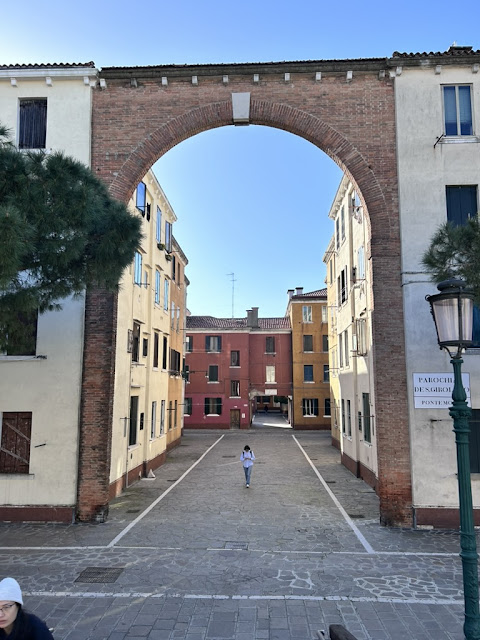Feelings of the Day: I want to quote from the definitive Anne Frank Diary, which I had brought along to read. It is important history, provides life lessons, and is a masterwork of personal narrative: “In everything I do, I can watch myself as if a stranger. I can stand, across from that everyday Anne and, without being biased or making excuses, watch what she’s doing, both the good and the bad. This self-awareness never leaves me, and every time I open my mouth, I think, “You should have said that differently.” or “That’s the way it is.” I condemn myself in so many ways that I’m beginning to realize the truth of my father’s adage: “Every child has to raise itself.” We can learn a lot from Anne Frank.
Full Day’s Events: Today I was visiting the Cannaregio (Royal Canal) district, including the Jewish Ghetto, in the North West of Venice. The contrast, in this area, was obvious in the North part of this area. Originally estates, gardens, convents, and monasteries were created here in the 11th century as the gateway to Venice. After the building of the train station and bridge to the mainland, in the 19th century, it has become mostly large apartment/condo buildings and to the far West a university. Even though the combination of water, bridge, building, and church was skewed to the above set of parameters I was still finding them novel and eye-worthy.
I visited the Madonna dell’Orto church, beside an ex-convent, and am thinking I like a new artist I was not familiar with before: Jacopo Robusti known as Tintoretto. A Venetian who lived in the 1500’s, he was known for strong and fast painting. He got the nickname from his father’s job as a dyer of cloth (tintore), so the little dyer is Tintoretto. I just feel lighter and happier, versus other paintings, when around his work. Its a nice difference. He was buried inside this church and works by him and his son are here.
Tintoretto's "Presentazione al tempio della vergine", 1552-53
Tomb of Tintoretto, 1519-1594
After having a lunch break at my place, I returned to cross bridges and visit the Jewish ghetto. Having seen the grand synagogue in Rome I declined seeing any more synagogues in this area because there were so many: German, Canton, Italian, Levantine, Ashkenazi, and Spanish/Portuguese! I am glad there is a strong enough congregation in each because of what happened here during two periods of history.
The Jewish ghetto was established by decree of the Venetian Republic, on 29 March 1516, until Napoleon occupied the city and ended its use. The word ghetto has many theories, but the Jewish Museum in Venice prefers the origin to be the Italian word gettare that means garbage, as the nearby cannon foundry dumped their waste here. German Jews who came to Venice pronounced it ghetto. Jews during the decree had to stay on the island, its two bridges closed after dark, and had guards paid by the Jewish community.
In 1938, the ruling Italian fascists eliminated civil rights for Jews. In September 1943 the occupying German Nazis hunted and deported Jews from Italy, but some were imprisoned within Italy. Both in Rome and in Venice I saw bronze cobblestones indicating who was taken, when, to where, and when they died. It is a deplorable government or group that wishes to deprive liberty and life to those they wish to blame for their own troubles. There were several bronze plaques that depicted scenes of Nazi activities and they touched my heart strongly. Perhaps it was because I was currently reading Anne Frank’s diary, but I think anyone with empathy could be moved by those plaques.
Leaving the ghetto island, I encountered a kosher bakery and picked out some delights.
With revitalized energy, from one of the cookies I ate, I continued walking and visited the church of Sant Alvise. Soon I was getting tired, but did spend time picking up a better map than my printouts and Rick Steves map. I wanted something to mark each bridge, as I crossed it.
Sant Alvise
Walkabout pictures.
Once home I carried on with my regular evening schedule of writing my travel diary, cooking, cleaning, reading, and bed. 16.2 km, 6 flights, and 56 new bridges crossed.







































No comments:
Post a Comment